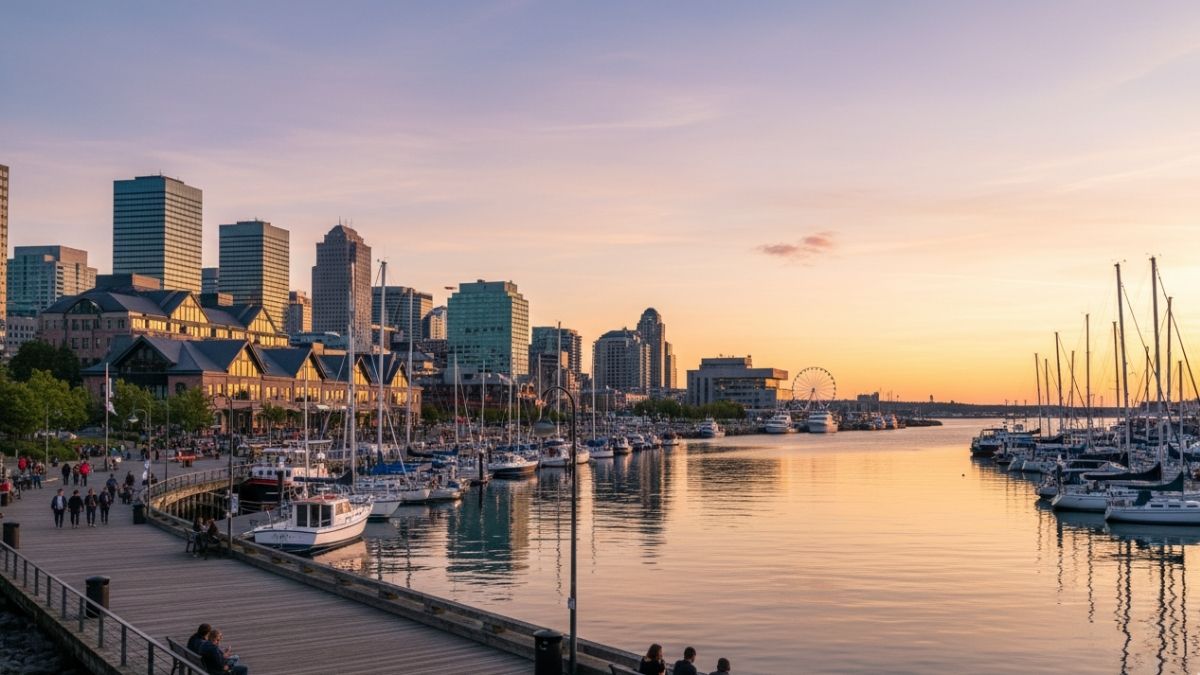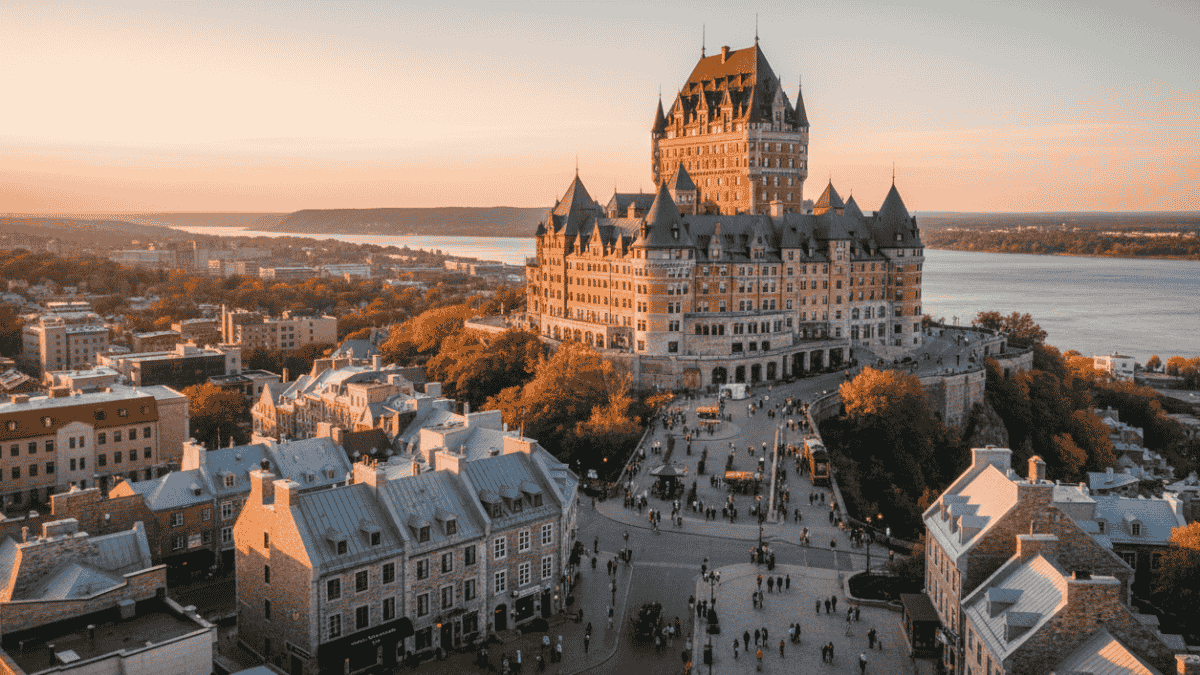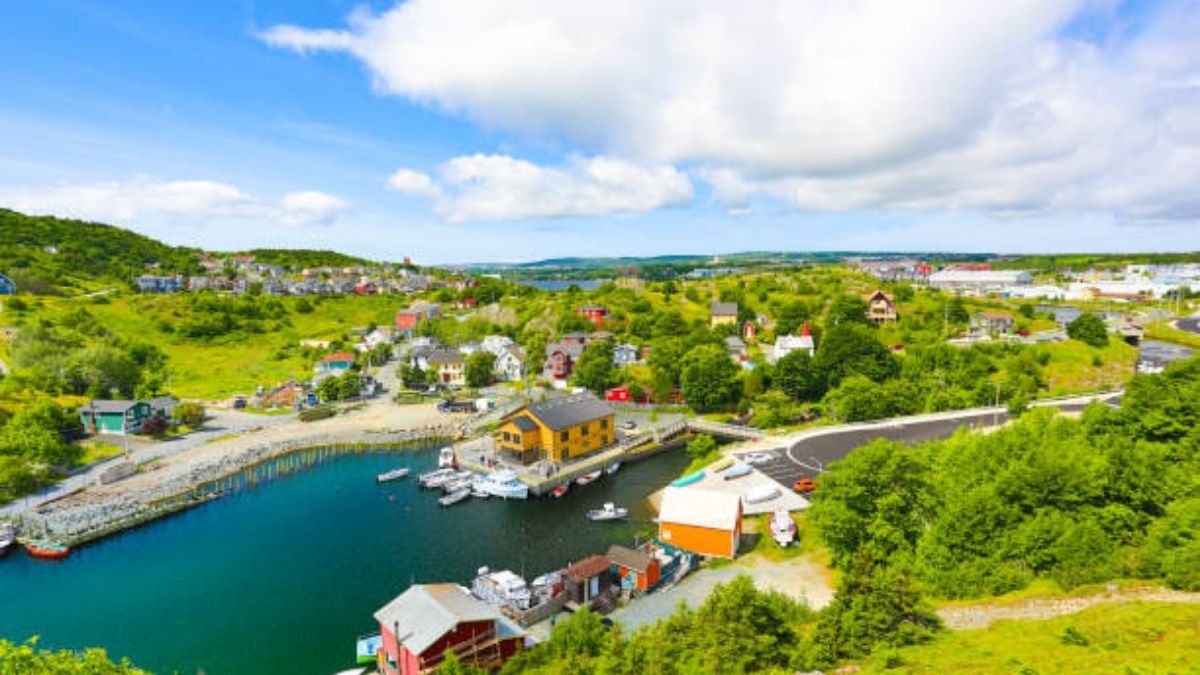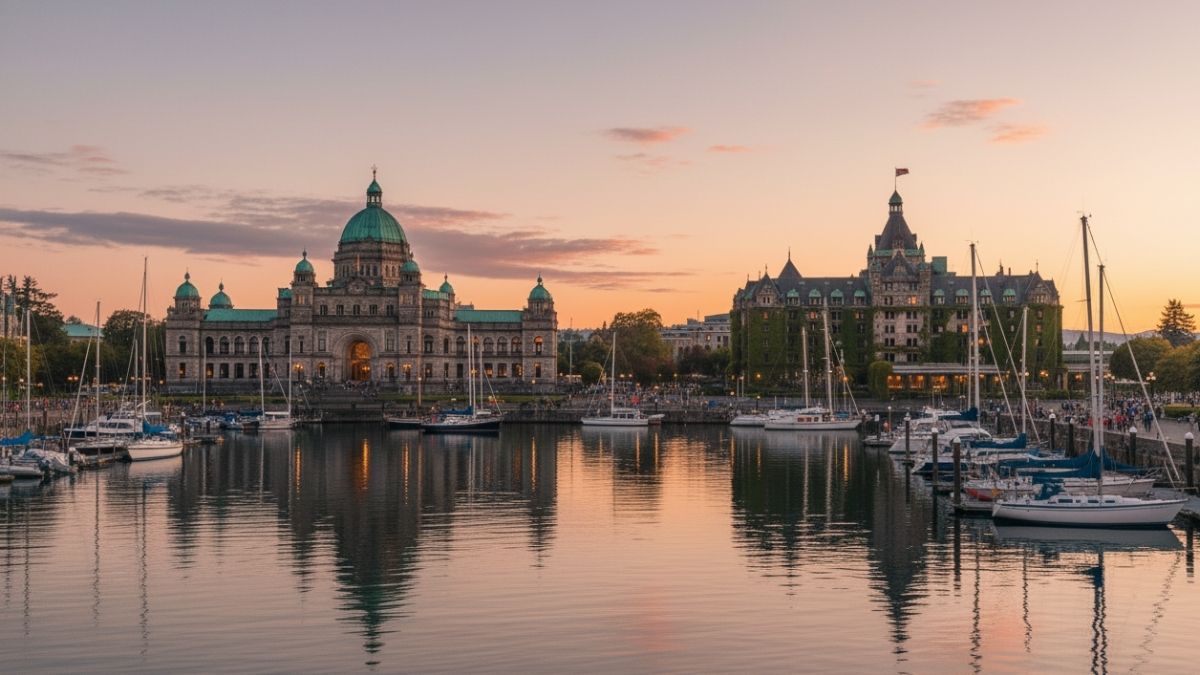If you’ve ever dreamed of an island escape where rugged cliffs meet Celtic music, where every turn along the road reveals another breathtaking view—welcome to Cape Breton Island, Nova Scotia. This is one of Canada’s most scenic treasures, and it’s about to become your new favorite place.
Cape Breton feels like a world apart—calm, dramatic, and deeply rooted in history. Whether you’re coming for the world-famous Cabot Trail, a cozy stay in a lakeside inn, or a weekend of Cape Breton Island hiking, this guide walks you through everything you need to know: geography, how to get here, the best areas to stay, and a few insider tips you’ll be glad to have before you go.
If you’d love the complete Cape Breton Island experience — with step-by-step itineraries, smart packing tips, local laws, and insider advice on the best places to stay — grab your FREE Cape Breton Travel Guide eBook today.
But if you prefer the feel of a real book in your hands. You can also order the paperback edition on Amazon or Lulu Bookstore.
Simply enter your name and email below to get instant access to your free download.
Planning your adventures just got easier with WorldTourGuide. And while you’re prepping for this trip, don’t miss our Traveler’s Toolkit — trusted by explorers worldwide in our travel community to plan smarter, pack lighter, and travel better. You’ll thank yourself later for making this choice.
The Geography and Landmarks of Cape Breton Island
Cape Breton isn’t just a dot on the map—it’s a landscape that feels alive.

This destination is located on the northeastern tip of Nova Scotia, this island is separated from the mainland by the Canso Causeway, a bridge that connects you to a whole new world of ocean views, mountain air, and culture.
The island spans about 10,000 square kilometers, so there’s plenty to explore—from coastal cliffs to forested valleys and small fishing harbors. The Cape Breton Highlands in the north steal most of the spotlight, and for good reason. These rolling highlands rise dramatically above the sea, carving out some of the most striking scenery in Canada. The famous Cabot Trail loops through this region, treating travelers to endless lookout points, winding drives, and charming communities along the way.
In the south, you’ll find softer landscapes—farms, rivers, and quiet lakeside villages. The centerpiece of the island is Bras d’Or Lake, a massive inland sea that sparkles under the sun and offers calm waters for sailing and kayaking. It’s no wonder locals call it “the heart of Cape Breton.”
But this island’s beauty goes hand in hand with history. Long before explorers arrived, the Mi’kmaq Nation called this place home. They named it Unama’ki, meaning “Land of Fog.” Their influence is still present in art, language, and storytelling across the island. Later came the French, who built the Fortress of Louisbourg, a massive 18th-century fortified town that still stands today. Strolling along its cobblestone streets feels like stepping into another era.
After the British takeover, waves of Scottish immigrants brought their Gaelic music, traditions, and energy—roots that are still alive today. You’ll hear it in fiddle tunes, taste it in oatcakes, and see it in the friendly gatherings known as ceilidhs (pronounced KAY-lees).
If you love history, nature, and a warm sense of community, Cape Breton is a place where it all blends beautifully.
To explore Cape Breton Island’s rugged coasts, folklore, and culture, check out the Destination Cape Breton official guide.
How to Get There: Flights, Ferries, and Road Trips
Reaching Cape Breton Island is surprisingly easy, whether you’re coming from elsewhere in Canada, the U.S., or even other countries.
By Air
The main airport is JA Douglas McCurdy Sydney Airport (YQY), located near Sydney on the island’s east coast. You can fly here directly from Halifax, Toronto, or Montreal, with seasonal routes added in summer. From the airport, car rentals are available on-site—a must if you want to explore freely.
By Road
If you love scenic drives, this one’s for you. The island connects to mainland Nova Scotia via the Canso Causeway. From Halifax, it’s a roughly 4 1⁄2-hour drive along the Trans-Canada Highway (Highway 104 → 105). The route itself is worth the trip: forests, ocean glimpses, and roadside diners serving hot seafood chowder.
Once on the island, Highway 105 cuts across the interior, linking towns like Baddeck, Whycocomagh, and Sydney. You can easily branch off toward the Cabot Trail, Ingonish, or the Margaree Valley from there.
By Ferry
For a more adventurous arrival, hop on a Marine Atlantic ferry from Newfoundland to North Sydney. These overnight and daytime routes are comfortable, scenic, and ideal if you’re road-tripping between provinces. Book in advance—summer departures fill quickly.
Getting Around
Since public transportation is scarce, renting a car is the most convenient option. It lets you stop for lookouts, explore side roads, and visit remote beaches. Just keep an eye on fuel levels—gas stations can be far apart in rural areas.
Best Areas to Stay on Cape Breton Island
One of the joys of traveling here is picking the perfect base for your style. Whether you want lakeside tranquility, mountain hikes, or seaside charm, here are the top areas—and what to expect from each.
1. Baddeck – The Heart of the Island
Baddeck sits right on Bras d’Or Lake and feels like the island’s unofficial capital for travelers.

This place is small, walkable, and filled with inns, gift shops, and cafés.
- Pros: Central location, ideal for exploring both east and west sides of the island. Home to the Alexander Graham Bell National Historic Site.
- Cons: Gets busy in summer—book early!
2. Ingonish – Highlands and Beaches
Perched inside Cape Breton Highlands National Park, Ingonish is a paradise for hikers and nature lovers.
- Pros: Direct access to trails, beaches, and golf courses.
- Cons: Remote; dining and stores are limited.
3. Cheticamp – Acadian Charm
This coastal town has deep French-Acadian roots and incredible sunset views.
- Pros: Cultural richness, art galleries, and live music.Cons: Quiet nightlife.
4. Sydney – Convenient and Urban
If you want more amenities without losing the coastal feel, Sydney is your go-to.
- Pros: Airport access, variety of hotels, and restaurants.
- Cons: More functional than scenic.
5. Margaree Valley – Countryside Peace
Rolling hills, rivers, and fishing lodges define this serene valley.
- Pros: Authentic rural atmosphere and local hospitality.
- Cons: You’ll need a car for everything.
6. St. Peter’s – Lakeside Gateway
At the southern tip of the island, St. Peter’s opens onto Bras d’Or Lake.
- Pros: Quiet charm, great boating and kayaking.
- Cons: Fewer restaurants and shops.
Tip: Book accommodations at least two months ahead if you’re traveling in July–October. Fall foliage season and the Celtic Colours Festival attract visitors from all over the world.
N.B.: If you organize your trip early and pack smart using our recommended travel gear essentials and trusted travel and affiliate partners below, you’ll skip the “I wish I knew” stress. From booking flights to finding the best travel deals, these are the gears that make every journey smoother — and save you money while you’re at it.
Cabot Trail and Hiking Highlights
If there’s one experience you can’t miss, it’s the Cabot Trail—a 298-kilometer loop around northern Cape Breton that’s considered one of the world’s top scenic drives.

This route passes through Cape Breton Highlands National Park, hugging cliffs, crossing high plateaus, and revealing endless ocean views. Most travelers start in Baddeck or Margaree Forks, driving counterclockwise for the best coastal vistas.
Must-Do Hikes
- Skyline Trail (near Cheticamp): A 7.5 km loop leading to an epic wooden boardwalk over the cliffs. Sunset views here are unforgettable—and you might spot moose or whales.
- Franey Trail (Ingonish): Steep but worth it for panoramic views of Clyburn Valley and the Atlantic.
- Middle Head Trail: Short, scenic, and perfect for families. It juts between two ocean bays—bring a picnic.
- Acadian Trail: Forested paths and river crossings that showcase Cape Breton’s natural diversity.
Outdoor Adventures
Beyond hiking, you can go kayaking on Bras d’Or Lake, whale watching in Pleasant Bay, or cycling along quieter stretches of the Cabot Trail. Each season offers its own magic—wildflowers in spring, golden forests in fall, and deep-blue vistas year-round.
When hiking the Cabot Trail, don’t forget to check the Parks Canada Cape Breton Highlands National Park page for maps, trail information, and park services.
Where to Eat: Iconic Dishes and Local Flavors
Cape Breton’s food is as soulful as its music. With the Atlantic at its doorstep and centuries of culinary heritage, the island serves comfort and freshness in equal measure.
- Lobster and Snow Crab: The stars of Cape Breton seafood. Try Baddeck Lobster Suppers or waterfront eateries in North Sydney.
- Halifax-style Donair: A local twist on the gyro with sweet garlic sauce—grab one at Pizza Palace in Sydney.
- Acadian Dishes: In Cheticamp, taste rappie pie or fricot, hearty dishes passed down for generations.
- Scottish Treats: Oatcakes and tea are staples in cafés across the island—stop by The Dancing Goat Café in Margaree Valley.
- Moon Mist Ice Cream: A Maritime-only favorite with banana, grape, and bubblegum flavors. Try it at Farmer’s Daughter Country Market in Whycocomagh.
- Craft Drinks: Local breweries like Big Spruce Brewing and Breton Brewing Co. serve beers and ciders that taste like the island itself.
Dining here isn’t just eating—it’s storytelling through flavor.
Festivals and Music: The Soul of the Island
Cape Breton’s heart beats to music. You’ll hear fiddles, bagpipes, and Gaelic songs echoing through pubs, halls, and open fields.
The biggest celebration is the Celtic Colours International Festival each October, coinciding with peak fall colors. Artists from across the world gather for concerts, ceilidhs, storytelling, and craft fairs across the island.
In summer, KitchenFest! brings local musicians and dancers together for a week of lively tunes and Gaelic pride. If you’re near Cheticamp, the Acadian Festival in August bursts with parades, folk costumes, and home-cooked food.
Even when no big event is happening, you’ll find nightly music at spots like The Red Shoe Pub in Mabou or community centers hosting spontaneous ceilidhs. These gatherings aren’t performances—they’re conversations in rhythm.
Laws and Traveler Etiquette
To keep your Cape Breton trip smooth and respectful, a few quick facts:
- Legal drinking age: 19. Alcohol is sold only at NSLC stores or licensed venues.
- Public drinking: Not allowed on beaches, streets, or parks.
- Cannabis: Legal for adults 19+ but only in private spaces or designated areas.
- Smoking: Banned in enclosed public spaces and within 4 meters of entrances or patios.
- Driving: Seatbelts required, headlights on after dusk, and don’t exceed posted speed limits (often 80–100 km/h on highways).
- Littering: Heavily fined—recycling bins are everywhere, so use them.
Locals are welcoming but value politeness and quiet—especially in rural communities. A friendly wave or quick chat goes a long way here.
Safety, Weather, and Practical Tips
Cape Breton is incredibly safe, but it’s smart to travel prepared.
- Wildlife: Admire moose, foxes, or bears from a distance—never feed them.
- Weather: It changes fast. Pack layers, even in summer. Fog and rain can appear suddenly near the coast.
- Driving: The Cabot Trail’s curves demand attention. Go slow, especially in fog or at night.
- Connectivity: Cell service can fade in remote areas. Download offline maps before you go.
- Medical Care: Hospitals are located in Sydney, with smaller clinics in towns like Baddeck and Cheticamp.
- Travel Insurance: Recommended for international visitors.
Above all, respect the land. Locals live closely with nature, and they’ll love you for doing the same.
For itineraries, travel tips and local advice, see the Cape Breton section on Nova Scotia’s tourism site.
Tipping, Taxes, and Payment Facts
Understanding how money works in Nova Scotia saves you confusion later.
- Tipping: 15–20% at restaurants, 10–15% for taxis and tour guides.
- Sales tax: 15% HST added to most purchases.
- Payments: Credit and debit cards widely accepted; carry small cash for rural stops.
- Currency: Canadian dollars—$1 coins (“loonies”) and $2 coins (“toonies”).
- ATMs: Use bank-branded machines for better rates.
Prices displayed don’t include tax, so budget a little extra at checkout.
Before we wrap up this travel guide, here’s something truly exciting you won’t want to miss!
Our travel media agency, WorldTourGuide, has officially launched a Sponsored Trip Program — a rare opportunity where our most active fans, just like you, can earn a chance to explore their dream destination someday.
Imagine yourself standing on the cliffs of Cape Breton, watching the ocean crash below — and knowing that WorldTourGuide helped make it happen.
If you’re ready to see where this journey could take you, click here to learn how the program works and find out how you can join this purpose-driven adventure.
Final Thoughts
Cape Breton Island is more than just a destination—it’s a feeling.

It’s the sound of fiddles drifting through a seaside pub, the glow of sunset on red cliffs, and the calm of a starlit drive along the Cabot Trail.
Whether you stay in Baddeck, hike the Highlands, or join a ceilidh in Cheticamp, you’ll leave with memories that linger long after you’ve gone home.
And that wraps up our journey through Cape Breton Island! I’m wishing you smooth travels and unforgettable memories as you explore this breathtaking corner of Canada.
So pack your bags, charge your camera, and come see why Cape Breton is often called Canada’s island of pure magic — where rugged beauty meets soulful charm.
📘 Don’t forget your FREE Cape Breton Travel Guide eBook — if you missed it earlier, simply enter your name and email below to download instantly.
You’ll also receive future updates, insider travel tips, and exclusive offers from WorldTourGuide to help you plan smarter, explore deeper, and travel better.










